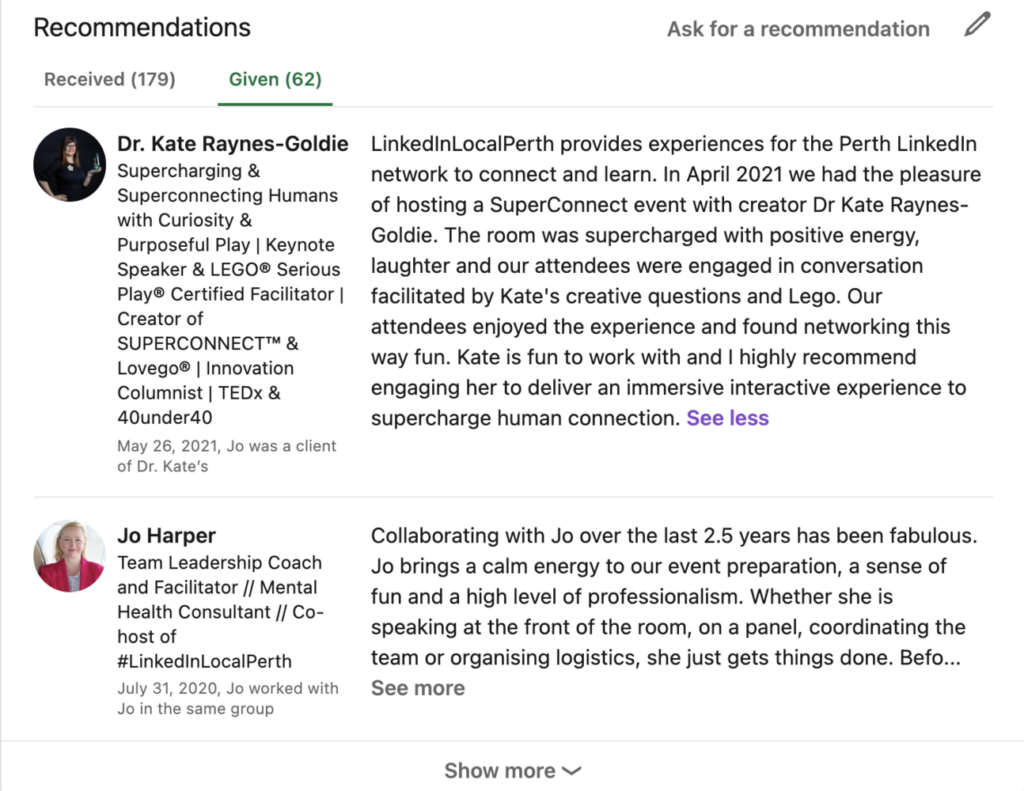How to Recommend Someone on LinkedIn: Step-by-Step Guide 2025
Table of Contents
Writing a LinkedIn recommendation might seem challenging, but it doesn’t have to be. This guide will show you exactly how to recommend someone on LinkedIn and write a recommendation that makes an impact.
Quick Guide: How to Recommend Someone on LinkedIn
Desktop Instructions:
- Visit the LinkedIn profile of the person you want to recommend
- Click the More button (three dots) near their profile photo
- Select Recommend.
- Choose your relationship and position at the time
- Write your recommendation
- Click “Send”
Mobile Instructions:
- Navigate to the profile of person you’d like to recommend.
- Tap the More button in the introduction section.
- Tap Recommend. This will take you to the How do you know [member name]? page.
- Select relationship and Select [member name’s] position at the time from the dropdowns, and tap Next.
- Write your recommendation.
- Click Send.
Writing Your Recommendations

Basic Structure
A good LinkedIn recommendation follows this format:
- Start with an attractive opening
- Explain how you know the person
- Describe specific achievements
- Include personal qualities
- End with a strong statement
Templates
Manager
“[Name] is an exceptional leader who combines strategic thinking with genuine care for their team. During our time at [Company], they [specific achievement] which resulted in [measurable result]. Their ability to [specific skill] while [another skill] makes them a valuable asset to any organization. I particularly remember when [specific situation] where they demonstrated [quality].”
Colleague
“I had the pleasure of working with [Name] for [time period] at [Company] where we collaborated on [project/responsibility]. [Name]’s expertise in [skill] contributed to [specific result]. What sets [Name] apart is their [unique quality] and [another quality]. For example, [specific example of their work].”
Direct Report
“[Name] reported to me at [Company] for [time period]. Their outstanding performance in [area] led to [specific achievement]. They consistently showed [quality] and [quality], making them a [positive description] team member. One project that highlights their abilities was [specific example].”
Real-Life Examples
- Leadership Recommendation: “Sarah transformed our marketing department during her 3-year tenure as Director. She introduced data-driven decision-making that increased our ROI by 150%. Beyond numbers, Sarah created a collaborative culture where creative ideas flourished. Her morning brainstorming sessions became legendary for producing innovative campaigns. Any company would be fortunate to have her strategic mind and inspiring leadership.”
- Technical Professional Recommendation: “David’s technical expertise in cloud architecture saved our company $200,000 in infrastructure costs. During our two-year collaboration, he led the migration of 15 legacy systems to AWS, completing each phase ahead of schedule. His ability to explain complex technical concepts to non-technical stakeholders made him invaluable during client presentations.”
- Client Service Recommendation: “Jennifer’s approach to client relationships goes beyond traditional account management. In one instance, she identified a $2M revenue opportunity by truly understanding our client’s business challenges. Her proactive problem-solving and attention to detail resulted in a 98% client retention rate.”
Pro Tips
Key Elements to Include:
- Specific achievements with numbers
- Personal anecdotes that illustrate skills
- Industry-relevant keywords
- Clear examples of leadership or expertise
- Measurable impact on business goals
Impact Statements to Use:
- “Increased team productivity by X%”
- “Led projects worth $X in revenue”
- “Improved customer satisfaction from X to Y”
- “Reduced costs by X% through innovation”
Let Recommendations Improve Your LinkedIn Profile
Why Recommendations Matter
Strong recommendations on LinkedIn do more than fill out your profile. When potential employers visit your profile, genuine recommendations serve as social proof of your abilities. These third-party endorsements back up the skills and experiences you list. Many hiring managers read recommendations to understand how others view your work style and abilities. A profile rich with thoughtful recommendations often appears higher in LinkedIn search results, making you more visible to recruiters.
Using AI to Boost Your Profile
Making your LinkedIn profile stand out takes time and effort, but AI tools can make this process easier and more effective. Jobright.ai works as your personal profile advisor, examining every aspect of your professional presence. The system analyzes your current profile against industry standards and successful profiles in your field. It then creates a detailed report showing where your profile shines and where it needs work.
Writing LinkedIn Recommendations: Tips That Work
Do’s:
- Be specific with examples
- Include numbers and results
- Keep it between 200-300 words
- Focus on professional qualities
- Proofread carefully
*According to Harvard Business Review’s guide on professional recommendations, being specific and authentic are key elements of a powerful recommendation.
Don’ts:
- Don’t write generic praise
- Avoid personal information
- Don’t exaggerate achievements
- Skip unrelated skills
FAQs
Q: How many recommendations should I write?
A: Quality matters more than quantity. Focus on writing meaningful recommendations for people whose work you know well.
Q: When should I write a recommendation?
A: Write recommendations when you have specific examples of someone’s good work, usually after completing a project together or at the end of a working relationship.
Conclusion
Writing effective LinkedIn recommendations is an important professional skill that benefits both the writer and the recipient. By following this guide’s structure and examples, you can create meaningful recommendations that highlight specific achievements and valuable qualities. Remember that authentic, detailed recommendations carry more weight than generic praise, so take time to reflect on your professional relationship before writing. Whether you’re giving or receiving recommendations, maintaining a strong LinkedIn profile is always crucial for your career growth.
